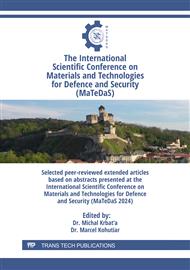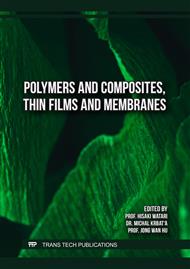[1]
G. Kaur, R.M. Singari, H. Kumar, A review of fused filament fabrication (FFF): Process parameters and their impact on the tribological behavior of polymers (ABS), Mater. Today: Proc. 51 (2022) 854-860.
DOI: 10.1016/j.matpr.2021.06.274
Google Scholar
[2]
S. Ranganathan, et al., The effect of print orientation and infill density for 3D printing on mechanical and tribological properties, SAE Technical Paper (2020).
DOI: 10.4271/2020-28-0411
Google Scholar
[3]
J. Loskot, et al., Influence of print speed on the microstructure, morphology, and mechanical properties of 3D-printed PETG products, Polym. Test. 123 (2023) 108055.
DOI: 10.1016/j.polymertesting.2023.108055
Google Scholar
[4]
S. Valvez, A.P. Silva, P.N.B. Reis, Optimization of printing parameters to maximize the mechanical properties of 3D-printed PETG-based parts, Polymers 14.13 (2022) 2564.
DOI: 10.3390/polym14132564
Google Scholar
[5]
M. Daly, et al., Effects of Infill Density and Pattern on the Tensile Mechanical Behavior of 3D-Printed Glycolyzed Polyethylene Terephthalate Reinforced with Carbon-Fiber Composites by the FDM Process, J. Compos. Sci. 8.4 (2024) 115.
DOI: 10.3390/jcs8040115
Google Scholar
[6]
A.H. Kadhum, S. Al-Zubaidi, S.S. AbdulKareem, Effect of the Infill Patterns on the Mechanical and Surface Characteristics of 3D Printing of PLA, PLA+ and PETG Materials, ChemEngineering 7.3 (2023) 46.
DOI: 10.3390/chemengineering7030046
Google Scholar
[7]
B.A. Aloyaydi, S. Sivasankaran, H.R. Ammar, Influence of infill density on microstructure and flexural behavior of 3D printed PLA thermoplastic parts processed by fusion deposition modeling, AIMS Mater. Sci. 6.6 (2019).
DOI: 10.3934/matersci.2019.6.1033
Google Scholar
[8]
R. Afshar, S. Jeanne, B.E. Abali, Effects of 3-D Printing Infill Density Parameter on the Mechanical Properties of PLA Polymer, in: Sixty Shades of Generalized Continua: Dedicated to the 60th Birthday of Prof. Victor A. Eremeyev, Springer Int. Publ., Cham, 2023, pp.1-12.
DOI: 10.1007/978-3-031-26186-2_1
Google Scholar
[9]
Y.C. Keat, Y.W. Yin, M.Z. Ramli, T.P. Leng, S.C. Chie, Effects of infill density on the mechanical properties of 3D printed PLA and conductive PLA, in: AIP Conference Proceedings, vol. 2129, no. 1, AIP Publishing, July 2019.
DOI: 10.1063/1.5118021
Google Scholar
[10]
K. Mayandi, et al., The effect of infill density on tensile properties of 3D printed chopped carbon fiber reinforced PLA composites materials, Interactions 245.1 (2024) 241.
DOI: 10.1007/s10751-024-02075-w
Google Scholar
[11]
S. Rilling, et al., Optimized infill density through topological optimization increases strength of additively manufactured porous polylactic acid, Int. J. Adv. Manuf. Technol. 129.7 (2023) 3739-3750.
DOI: 10.1007/s00170-023-12554-z
Google Scholar
[12]
A. Pandžić, D. Hodžić, E. Kadrić, Experimental Investigation on Influence of Infill Density on Tensile Mechanical Properties of Different FDM 3D Printed Materials, TEM J. 10.3 (2021).
DOI: 10.18421/tem103-25
Google Scholar
[13]
A.S. Karad, et al., Experimental study of effect of infill density on tensile and flexural strength of 3D printed parts, J. Eng. Appl. Sci. 70.1 (2023) 104.
DOI: 10.1186/s44147-023-00273-x
Google Scholar
[14]
ISO 527-2, Plastics-determination of tensile properties, part 2: test conditions for moulding and extrusion plastics, DIN EN ISO 527-2 (2012).
DOI: 10.3403/30216860
Google Scholar



